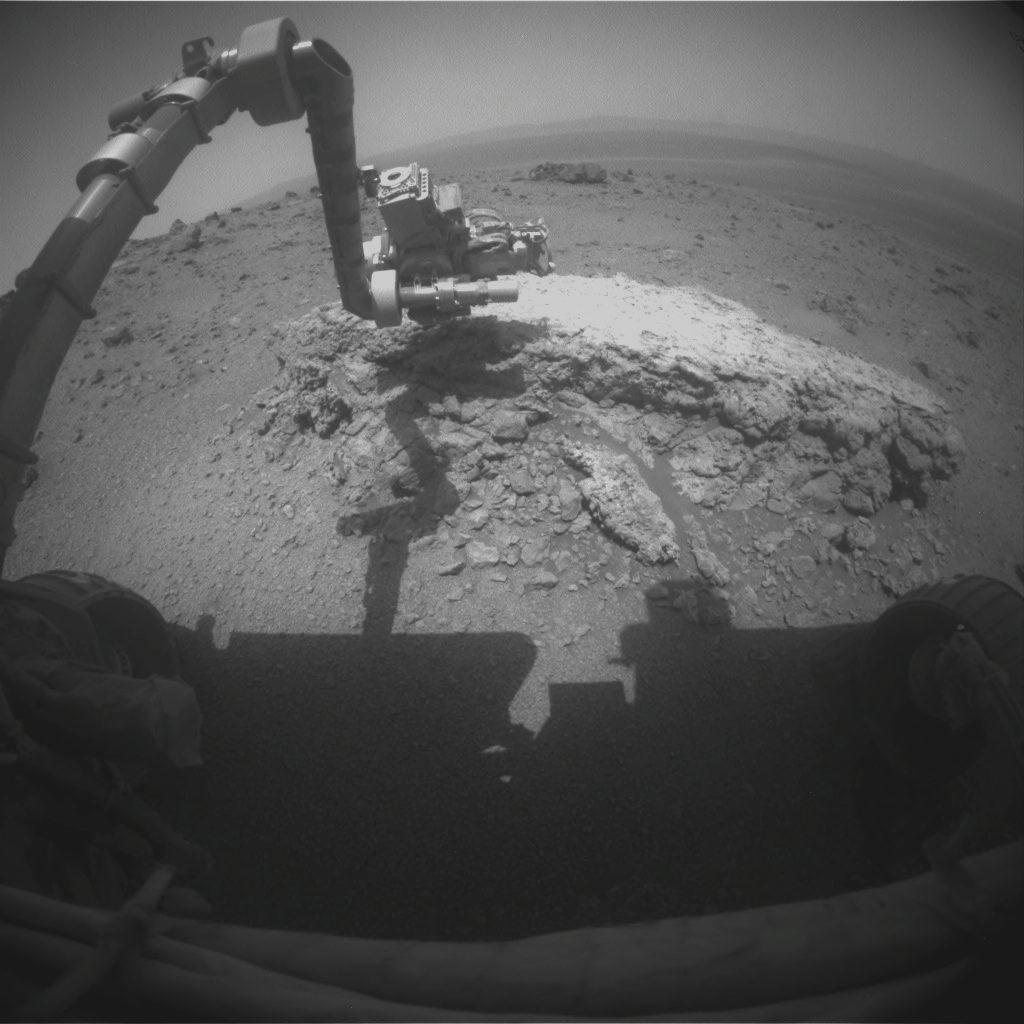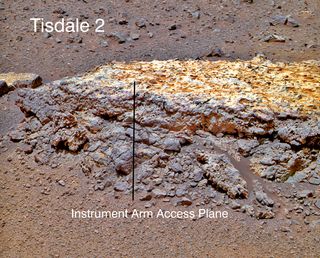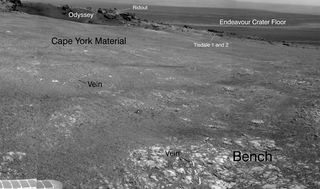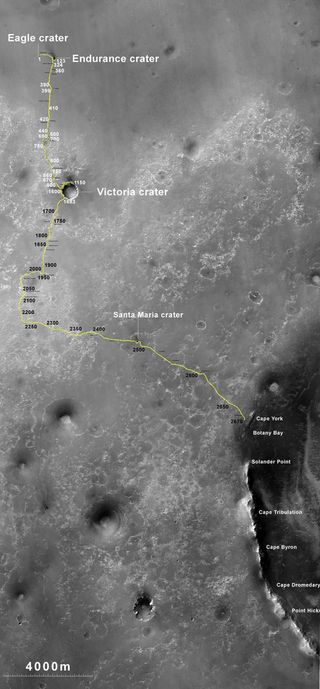
NASA's Mars rover Opportunity has found another spot where warm water may have flowed or percolated on the Red Planet long ago, researchers announced Thursday (Sept. 1).
Opportunity made the find while studying a rock on the rim of Mars' huge Endeavour Crater. The rock, called Tisdale 2, has unusually high levels of zinc and bromine, elements often deposited by water — especially hot water. The rock is unlike any ever seen on Mars, researchers said.
On Earth, life just needs water and energy to get a foothold, and hydrothermal systems teem with microbes. Such sites are thus good places to look for evidence of ancient life on Mars, which is cold and dry today.
Opportunity's twin rover, Spirit, discovered strong evidence of an ancient hydrothermal system near its landing site back in 2007. While researchers are still interpreting Opportunity's data, they think Endeavour's rim might well harbor another one. [Mars Photos by Spirit and Opportunity]
"When you find rocks on Earth that are rich in zinc, they typically formed in a place where you had some kind of hydrothermal activity going on," Steve Squyres of Cornell University, principal investigator for Spirit and Opportunity's mission, told reporters Thursday. "This is a clue that we may be dealing with a hydrothermal system here."

A cradle for life?
Endeavour is a giant impact crater about 14 miles (22 kilometers) across. Opportunity just arrived at its rim on Aug. 9, at a site called "Cape York." The region looks completely different than other parts of Mars that Spirit and Opportunity have explored, researchers said.
Get the Space.com Newsletter
Breaking space news, the latest updates on rocket launches, skywatching events and more!
Tisdale 2, which is about the size of a footstool, is the first rock the rover has examined in detail at Endeavour. So, researchers stressed, their investigation is still preliminary. They can't yet say for certain that Opportunity has uncovered a long-dead hydrothermal system — but it's a real possibility.
Further, this system might be even more exciting than the one Spirit found four years ago. The warm water in that system was likely to have been very acidic, Squyres said. So was a lot of the other water bubbling out of the Martian ground long ago, both near Spirit's site and near Opportunity's site.
But the rocks and soil around Endeavour might be more neutral, and thus more benign, researchers said. NASA spacecraft orbiting Mars have gathered compelling evidence that there are clay minerals in the area. And clay minerals don't form in acidic conditions.
"So if there really are clay minerals present, as we suspect there are," Squyres said, "then that points to water with a very different chemistry — water that's more neutral, and conditions that would have been more suitable for life."
A hydrothermal system doesn't necessarily mean flowing water, he added. Hot water vapor may have also moved through the rocks long ago.
And it was long, long ago — likely billions of years, researchers said.
The heat to power this system may have come from the impact that created Endeavour, Squyres said. Such a destructive event would have transferred mammoth amounts of heat to the red dirt and rocks.

Just getting started
Researchers hope to flesh out just what's going on at Endeavour over the coming weeks and months. Opportunity, after all, has only just begun studying the giant crater.
"Amazingly, after seven years and eight months, we're embarked on a brand-new mission," said Ray Arvidson, the rover mission's deputy principal investigator at Washington University in St. Louis. [Video: Opportunity's 7 Years of Mars Roving]
Opportunity and Spirit landed on Mars in January 2004, on what was planned to be just a three-month mission to search for signs of past water activity on Mars. Both robots delivered in a big way, finding lots of evidence that the Red Planet was a much wetter, warmer place in the ancient past.
The twin rovers then long outlasted their warranties.
Spirit stopped communicating with Earth in March 2010, and NASA pronounced the rover dead this past May. Opportunity, however, is still going strong. It has now covered 20.8 miles (33.5 km) on the Martian surface — more than 30 times its original distance objective.

Opportunity is showing some signs of its advanced age. Mission engineers have been driving the rover backward for the last few years, for example, to distribute the wear more evenly amongst the rover's gear mechanisms.
But the rover keeps chugging along. And it finally reached Endeavour, its destination since August 2008. The mission team is excited to start studying the crater's environs in detail.
"This has the potential to be the most revealing destination ever explored by Opportunity," said Dave Lavery, program executive for NASA's Mars Exploration Rovers at NASA Headquarters in Washington, D.C. "This region is substantially different than anything we've seen before."
You can follow SPACE.com senior writer Mike Wall on Twitter: @michaeldwall. Follow SPACE.com for the latest in space science and exploration news on Twitter @Spacedotcom and on Facebook.
Join our Space Forums to keep talking space on the latest missions, night sky and more! And if you have a news tip, correction or comment, let us know at: community@space.com.

Michael Wall is a Senior Space Writer with Space.com and joined the team in 2010. He primarily covers exoplanets, spaceflight and military space, but has been known to dabble in the space art beat. His book about the search for alien life, "Out There," was published on Nov. 13, 2018. Before becoming a science writer, Michael worked as a herpetologist and wildlife biologist. He has a Ph.D. in evolutionary biology from the University of Sydney, Australia, a bachelor's degree from the University of Arizona, and a graduate certificate in science writing from the University of California, Santa Cruz. To find out what his latest project is, you can follow Michael on Twitter.